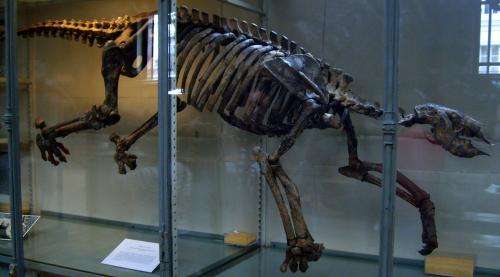Thalassocnus skeleton, Muséum national d'histoire naturelle, Paris. Credit: FunkMonk/Wikipedia
(Phys.org) —A team of researchers from the Sorbonne Universités have found evidence of an ancient sloth returning to the sea to survive. In their paper published in Proceedings of the Royal Society B: Biological Sciences, the team describes how they performed CT scans on a number of fossilized bones and in so doing discovered a change in density—evidence of a move to the sea.
The sloths in question, different species of Thalassocnus, lived approximately four to eight million years ago—their fossilized bones have been found along the coast of Peru, causing some to wonder if the animals actually lived more in the sea, than on land. At the time of their existence, the land area was mostly desert, which would have provided very little for the sloths to eat. A natural move to the sea would have made sense, though it would likely have been difficult at first as most land animals have bones that are not very dense—it keeps weight down thus requiring less energy to move about. When in water, however, such animals are more buoyant. To find out more, the researchers borrowed sloth bones from several museums and put them in a CT scanner to measure bone density. Because the bones had already been dated, it was easy for the researchers to see that as time passed, the bones of the sloths grew more dense (up to 20 percent)—over a period of just three million years—a clear sign of an evolutionary need to be less buoyant.
The researchers suggest that as food became more scarce, the sloths more and more took to the sea, first by standing in the water and eating sea grasses, then eventually swimming down to the sea floor in deeper areas as their bone density allowed them do so much easier.
Sadly, the evolutionary adaption proved fruitless in the end. As time passed, the Isthmus of Panama closed, preventing the warm waters of the Caribbean from reaching the Peruvian shores. As the water grew colder, either the plants the sloths fed on grew too sparse or the sloths themselves were unable to adapt once again—this time to the cold water. They perished, leaving behind nothing but their bones for modern scientists to examine and ponder.
More information: Gradual adaptation of bone structure to aquatic lifestyle in extinct sloths from Peru, Proceedings of the Royal Society B, Published 12 March 2014 DOI: 10.1098/rspb.2014.0192
Abstract
Non-pathological densification (osteosclerosis) and swelling (pachyostosis) of bones are the main modifications affecting the skeleton of land vertebrates (tetrapods) that returned to water. However, a precise temporal calibration of the acquisition of such adaptations is still wanting. Here, we assess the timing of such acquisition using the aquatic sloth Thalassocnus, from the Neogene of the Pisco Formation, Peru. This genus is represented by five species occurring in successive vertebrate-bearing horizons of distinct ages. It yields the most detailed data about the gradual acquisition of aquatic adaptations among tetrapods, in displaying increasing osteosclerosis and pachyostosis through time. Such modifications, reflecting a shift in the habitat from terrestrial to aquatic, occurred over a short geological time span (ca 4 Myr). Otherwise, the bones of terrestrial pilosans (sloths and anteaters) are much more compact than the mean mammalian condition, which suggests that the osteosclerosis of Thalassocnus may represent an exaptation.
Journal information: Proceedings of the Royal Society B
© 2014 Phys.org
























